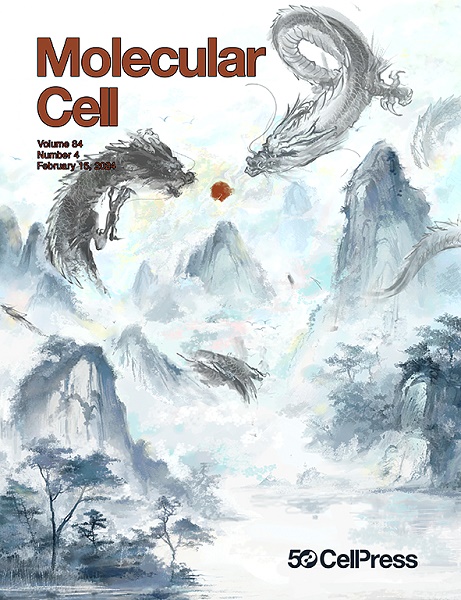人线粒体启动子识别和转录因子结合与释放的结构基础
IF 14.5
1区 生物学
Q1 BIOCHEMISTRY & MOLECULAR BIOLOGY
引用次数: 0
摘要
人类线粒体的转录是由一个核心装置驱动的,该核心装置由Pol a家族RNA聚合酶(mtRNAP)、起始因子TFAM和TFB2M以及延伸因子TEFM组成。虽然早期的起始和延伸复合物的结构提供了有价值的快照,但它们代表了一个高度动态和多步骤过程的孤立阶段。线粒体转录的关键方面,如DNA识别和融化,启动子逃逸和启动因子的释放,仍然知之甚少。在这里,我们展示了一系列低温电子显微镜(cryo-EM)结构,这些结构捕捉到了转录复合体从最初的开放启动子复合体过渡到中间阶段的过程。我们的数据揭示了启动子特异性的新的未知决定因素:mtRNAP与TFAM和启动子的连续分离,TFB2M的释放以及TEFM的募集。总之,这些发现提供了人类线粒体转录的详细分子机制。本文章由计算机程序翻译,如有差异,请以英文原文为准。

Structural basis for promoter recognition and transcription factor binding and release in human mitochondria
Transcription in human mitochondria is driven by a core apparatus consisting of a Pol A family RNA polymerase (mtRNAP), the initiation factors TFAM and TFB2M, and the elongation factor TEFM. While earlier structures of initiation and elongation complexes provided valuable snapshots, they represent isolated stages of a highly dynamic and multistep process. Critical aspects of mitochondrial transcription—such as DNA recognition and melting, promoter escape, and the release of initiation factors—remain poorly understood. Here, we present a series of cryoelectron microscopy (cryo-EM) structures that capture the transcription complex as it transitions from the initial open promoter complex to the processive elongation complex through intermediate stages. Our data reveal new, previously unidentified determinants of promoter specificity: the sequential disengagement of mtRNAP from TFAM and the promoter, the release of TFB2M, and the recruitment of TEFM. Together, these findings provide a detailed molecular mechanism underlying transcription in human mitochondria.
求助全文
通过发布文献求助,成功后即可免费获取论文全文。
去求助
来源期刊

Molecular Cell
生物-生化与分子生物学
CiteScore
26.00
自引率
3.80%
发文量
389
审稿时长
1 months
期刊介绍:
Molecular Cell is a companion to Cell, the leading journal of biology and the highest-impact journal in the world. Launched in December 1997 and published monthly. Molecular Cell is dedicated to publishing cutting-edge research in molecular biology, focusing on fundamental cellular processes. The journal encompasses a wide range of topics, including DNA replication, recombination, and repair; Chromatin biology and genome organization; Transcription; RNA processing and decay; Non-coding RNA function; Translation; Protein folding, modification, and quality control; Signal transduction pathways; Cell cycle and checkpoints; Cell death; Autophagy; Metabolism.
 求助内容:
求助内容: 应助结果提醒方式:
应助结果提醒方式:


